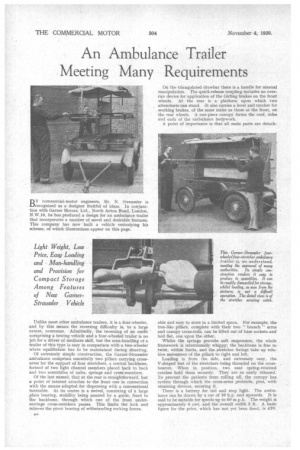An Ambulance Trailer Meeting Many Requirements
Page 34

If you've noticed an error in this article please click here to report it so we can fix it.
DY commercial-motor engineers, Mr. N. Straussler is L./recognized as a designer fruitful of ideas. In conjunction with Garner Motors, Ltd., North Acton Road, London, N.W.10, he has produced a design for an ambulance trailer that incorporates a number of novel and desirable features. This company has now built a vehicle embodying his scheme, of which illustrations appear on this page.
Unlike Most other ambulance trailers, it is a four-wheeler, and by this means the reversing difficulty is, to a large extent, overcome. Admittedly, the reversing of an outfit comprising a towing vehicle and a four-wheeled trailer is no job for a driver of mediocre skill, but the man-handling of a trailer of this type is easy in comparison with a two-wheeler .where equilibrium has to be maintained during shunting.
Of extremely simple construction, the Garner-Straussler ambulance comprises essentially two pillars carrying crossarms for the support of four stretchers, a central backbone, formed of two light channel members placed back to back and two assemblies of axles, springs and cross-members.
Of the last named, that at the rear is straightforward, but a point of interest attaches to the front one in connection with the means adopted for dispensing with a conventional turntable. At its centre is a swivel, consisting of a large plain bearing, stability being assured by a guide, fixed to the backbone, through which one of the front undercarriage cross-members passes. This limits thelock and relieves the pivot bearing of withstanding rocking forces.
On the triangulated drawbar there is a handle for manual manipulation. The quick-release coupling includes an overrun device for application of the Girling brakes on the front wheels. At the rear is a platform upon which two attendants can stand. It also carries a lever and ratchet for working brakes, of the same make as those at the front, on the rear wheels. A one-piece canopy forms the roof, sides and ends of the ambulance bodywork.
A point of importance is that all main parts are detach able and easy to store in a limited space. For example, the tree-like pillars, complete with their two " branch " arms and canopy cross-rods, can be lifted out of base sockets and laid flat, one upon the other.
Whilst the springs provide soft suspension, the whole framework is intentionally whippy; the backbone is free to twist, within limits, and the stretcher fixings take up relative movement of the pillars to right and left.
Loading is from the Side, and extremely easy, the V-shaped feet of the stretchers being threaded on the crossbearers. When in position, two neat spring-retained catches hold them securely, They are as easily released. To prevent the patients from rolling off, the canopy has eyelets through which the cross-arms protrude, pins, with retaining devices, securing it.
There is a battery for tail and stop light. The ambulance can be drawn by a car of 10 h.p. and upwards. It is said to be suitable for speeds up to 60 m.p.h. The weight is approximately 6 cwt. and the overall width 5 ft. A basic figure for the price, which has not yet been fixed, is £70.




























































